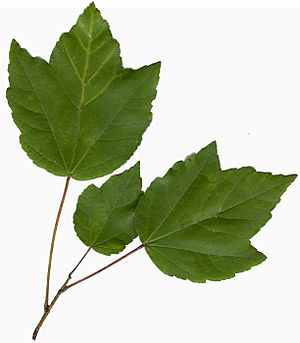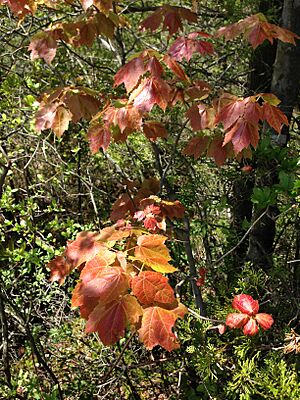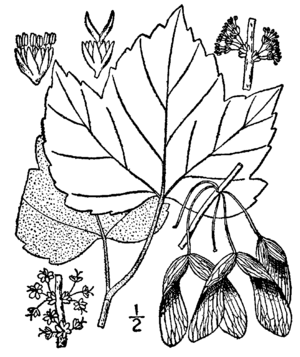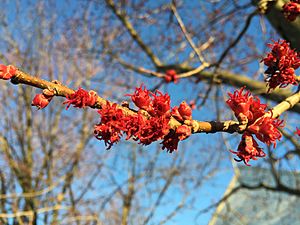Red maple facts for kids
Quick facts for kids Red maple |
|
|---|---|
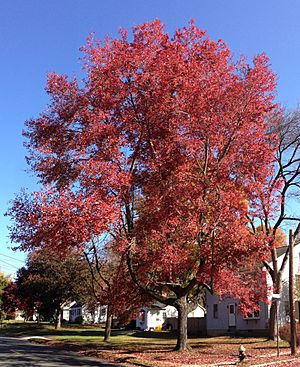 |
|
| Conservation status | |
| Scientific classification | |
| Genus: |
Acer
|
| Species: |
rubrum
|
 |
|
The Acer rubrum, also known as the red maple, is a very common tree found across eastern and central North America. You might also hear it called the swamp, water, or soft maple. It's one of the most widespread trees in this part of the world. In fact, the U.S. Forest Service says it's the most abundant native tree in eastern North America!
Red maples grow from southeastern Manitoba all the way east to Newfoundland, and south to Florida and East Texas. They can reach about 30 meters (100 feet) tall. Many parts of the tree, like its flowers, twigs, and seeds, have a reddish color. But what people love most about the red maple is its amazing bright red leaves in autumn.
This tree can grow in many different places, from wet swamps to dry soils. It grows well from sea level up to about 900 meters (3,000 feet) high. Because of its beautiful fall colors, it's often planted in yards and parks. People also use it to make a small amount of maple syrup and for its wood. The red maple is even the state tree of Rhode Island!
Contents
What Does a Red Maple Look Like?
The red maple is usually easy to spot, but its look can change a lot. It's a medium to large tree, often growing 27 to 38 meters (90 to 125 feet) tall. Some can even grow over 41 meters (135 feet) in places like the southern Appalachians. The trunk can be 46 to 88 centimeters (18 to 35 inches) wide. Trees growing in open areas are usually shorter and wider with a rounder top.
When the tree is young, its bark is smooth and light gray. As it gets older, the bark turns darker and develops long, slightly raised cracks. The largest known living red maple is in Michigan. It's about 38 meters (125 feet) tall!
Red Maple Leaves
The leaves are the easiest way to tell a red maple from other maples. Like all maples in North America, their leaves fall off in autumn. They grow opposite each other on the twig. Red maple leaves are usually 5 to 10 centimeters (2 to 4 inches) long and wide. They have 3 to 5 pointed parts, called palmate lobes, with jagged edges. The parts near the tip are usually bigger than the ones near the base.
The top of the leaf is light green, and the underside is whitish. The leaf stems are usually red and can be up to 10 centimeters (4 inches) long. In autumn, the leaves turn a brilliant red, but some can also be yellow or orange. The color can depend on the soil and if the tree has male or female flowers. Red maples show their best fall colors in cooler northern areas.
Twigs and Buds
The twigs of the red maple are reddish and a bit shiny. You might see small bumps called lenticels on them. The buds are usually blunt and can be greenish to reddish. They form in the fall and winter and are often easy to see because they are large and red.
Red Maple Flowers and Seeds
Red maple flowers are usually male or female, growing in separate clusters. They appear in late winter or early spring, often before the leaves. Some trees have only male flowers, some only female, and some have both! A red maple can start blooming when it's about 8 years old.
The flowers are red with 5 small petals. The female flowers hang down on long stems. The male flowers have 4 to 12 stamens.
The fruit of the red maple is a samara, which is a winged seed. They grow in pairs, about 15 to 25 millimeters (0.6 to 1 inch) long, with wings that spread out. They ripen from April to early June, even before the leaves are fully grown. Once ripe, the seeds are spread by the wind for about one to two weeks.
Where Red Maples Grow
Acer rubrum is one of the most common trees in eastern North America. It grows from southern Newfoundland down to Florida, and west to East Texas. This tree covers a huge area, about 2,600 kilometers (1,600 miles) from north to south! It's found in all states east of the 95th meridian.
Red maples can grow in many different types of soils. They don't mind if the soil is wet or dry, or if it has different levels of acidity. This is why they are so widespread! They grow well in moderately moist places at lower or middle elevations. But you can also find them on dry ridges in mountains or in swampy areas. In the far south, they are almost always found in swamps.
Red maples are much more common today than they were a long time ago. This is partly because of human activities like logging. Also, diseases have reduced other trees like American elm and American chestnut, giving red maples more room to grow. Red maples often grow quickly in young forests that have been disturbed, but they are less common in very old, mature forests.
How Red Maples Live and Grow
Red maples can live up to 150 years, but most live less than 100 years. Their thin bark can be easily damaged by ice, storms, or animals. This can let fungi get inside and cause the tree to rot.
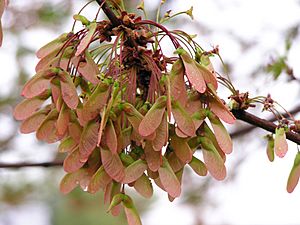
Red maples are very good at growing in different places because they can change their roots. In wet areas, they grow short main roots with long side roots. In dry areas, they grow long main roots with shorter side roots. Their roots mostly spread out horizontally in the top 25 centimeters (10 inches) of the ground. Mature trees can have roots up to 25 meters (80 feet) long! They can handle a lot of flooding and also survive droughts.
Reproduction and Life Cycle
The red maple is one of the first trees to flower in spring. It produces seeds almost every year, with a very large crop often happening every other year. A single tree can produce tens of thousands of seeds in a season. A large tree could even produce almost a million seeds!
The seeds usually sprout in early summer soon after they are released, if they have enough light, moisture, and warmth. If it's too shady, they might not sprout until the next spring. Most young seedlings don't survive in very shady forests. However, young seedlings (one to four years old) are common under dense tree cover. They wait there, ready to grow quickly if an opening appears in the forest above them.
Red maples can grow much more when other trees are damaged by disease, cutting, or fire. They are fast growers. In good light and moisture, seedlings can grow 30 centimeters (1 foot) in their first year and up to 60 centimeters (2 feet) each year for the next few years.
Many animals use the red maple for food. Elk and white-tailed deer eat the new growth of red maples in winter. Several types of butterflies and moths also eat the leaves, including the rosy maple moth.
Because red maples grow in so many different places, trees from different regions can be quite different. For example, trees from the north tend to sprout earlier and have redder fall colors. This variety means that red maples can be grown in many different environments.
Red maples often mix with silver maples to create a hybrid tree called Freeman's maple (Acer × freemanii). This hybrid has features from both parent trees.
Allergies from Red Maples
Some red maple trees can cause allergies, but it depends on the type.
- High Allergy Risk: Some types of red maples are completely male trees and produce a lot of pollen. These include 'Autumn Flame', 'Autumn Spire', and 'Sun Valley'.
- Low Allergy Risk: Other types are completely female trees and produce very little pollen, so they are less likely to cause allergies. These include 'Autumn Glory', 'October Glory', and 'Red Sunset'.
Is Red Maple Toxic?
The leaves of red maple, especially when they are dead or wilted, are very toxic to horses. The leaves contain something that harms red blood cells, making it hard for the horse's body to get enough oxygen. This can be very dangerous for horses.
Growing Red Maples
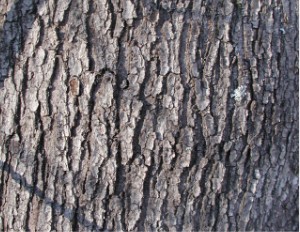
Red maples are very popular trees to plant because they grow fast, are easy to move, look nice, and provide food for wildlife. They are one of the most common trees planted in cities and parks. Their popularity comes from their strong growth, pretty red flowers that appear early, and especially their bright red fall leaves. Red maples were first brought to the United Kingdom in 1656.
Red maples are a good choice for city areas if there's enough space for their roots. They can handle pollution and road salt better than sugar maples. However, their roots can spread out widely and sometimes cause problems with sidewalks or driveways. Squirrels like to eat their buds in early spring.
Red maples can also be shaped into beautiful bonsai trees.
Popular Types of Red Maples
Many different types of red maples have been developed, often chosen for their intense fall colors. 'October Glory' and 'Red Sunset' are two of the most popular. Here are a few others:
- Armstrong – Tall and narrow with silver bark and orange to red fall leaves.
- Autumn Blaze – Has a rounded shape with leaves like a silver maple. Its orange-red fall color lasts a long time.
- Autumn Flame – Grows fast and has amazing bright red fall color that appears early.
- October Glory – Has a rounded shape with intense red fall leaves that appear later in the season. It grows strongly and reliably.
- Red Sunset – This type handles heat well and grows upright. It has very attractive orange-red fall colors and grows quickly.
Other Uses for Red Maple
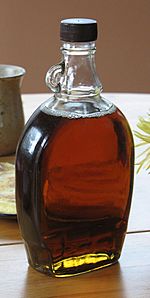
In the wood industry, red maple is called a "soft maple." This means its wood is softer than "hard maples" like sugar maple, but it's still quite strong. Red maple wood is often less expensive than hard maple. It's also easier to work with and stain. So, good quality red maple wood can be used for furniture.
Red maple can also be used to make maple syrup, just like sugar maples. However, the buds of red maples open much earlier in spring. Once the buds open, the sap changes and gives the syrup a bad flavor. This means red maples can only be tapped for syrup for a very short time before their buds appear.
Native Americans used red maple bark for different purposes. They used it to help with eye problems and muscle aches. They also made tea from the inner bark to treat coughs and diarrhea. Early settlers used an extract from the bark to make brown and black dyes.
Red maple wood is also used for firewood, though it doesn't produce as much heat as some other hardwoods like oak or ash.





